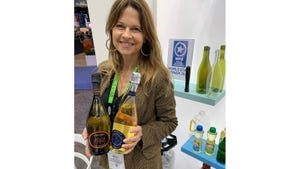Automation:
May 1, 1997
As a $120 million/year custom molder with clients such as Kraft, Nabisco, Lever Brothers, and others, Landis Plastics Inc. (LPI) recognizes the need to be central to its customers. To that end, in 1994 it located a new 135,000-sq-ft, state-of-the-art injection molding and high-speed printing facility in Solvay, NY, a suburb of Syracuse. No expense was spared to make the Solvay plant the company's best to date.
| Landis Plastics molds a wide variety of food containers ranging from 1 oz to 5 gal for its Fortune 500 customers. |
The plant operates 12 Husky machines: nine with 500 tons clamping force, one 600-ton press, and two 400-tonners. Landis and Husky worked together and pioneered new technology used at Landis' new facility at Husky's Advanced Manufacturing Center in Toronto.
Three four-level stack molds produce several million lids daily for yogurt and whipped topping containers produced at the plant. As little as 10 years ago, all of the lids LPI produced were stacked and packed by hand, explains Rob McLeland, molding manager at the Solvay plant. Now, automated lid orientation systems from CBW Systems in Fort Collins, CO do all that work faster and more efficiently.
"When we moved to the high-cavitation stack molds, operators and our older semiautomatic systems couldn't keep up," McLeland explains. "As the molds get bigger and the molding process gets faster, we have to upgrade our older automation equipment to keep up."
Automation also helps to minimize handling of the products, which results in cleaner parts and fewer quality problems. Even in the printing plants, Systec provides the fully-automated robotic systems that can take each container through the printing process with minimal human handling. LPI even designed and developed a special system for handling straight-wall containers.
| Automation is an important part of Landis' operation. Here, special carousel feeders supply lids into high-speed printing presses. |
Additionally, automation is essential to meeting the high productivity and efficiency rates in the Landis plants. In fact, wall thicknesses for molded containers have been reduced from .035 inch in the 1960s to .018 inch today. Molding cycles are three times faster and mold sizes have more than doubled.
Each container molding system includes fully automated handling and robotic systems, including high-speed, pick-and-place robots that remove the containers from the multicavity stack molds in cycle. Automated orientation systems set the containers upright and convey them to stackers in preparation for printing.
State-of-the-art systems exist throughout the plant, including a high-speed conveyor system that can unload 180,000 lb of resin from rail cars to LPI's silos in 8 hours.
| Robotics are used to aid hands-free production and accommodate fast-cycle molding from multicavity stack molds. |
One of LPI's biggest challenges is finished goods inventory control for the millions of products that move from manufacturing, through printing, and to the warehouse each day for stocking and shipping. To ensure accurate counts and facilitate storage, each plant incorporates a customized voice-controlled warehouse data information system. Knowing how many of each product and precisely where the various products are stored is crucial to a high-volume molding operation such as LPI's.
Forklift drivers, who are equipped with headsets and microphones, receive computer-generated information as to location and number of units to pull for loading onto trucks for shipment. Drivers also feed information into the system as they move finished goods from manufacturing to inventory, which means that accurate counts as well as precise storage areas for each product line are assured.
LPI's newest additions to its printing departments include the latest equipment in that technology: eight-color, high-speed printing machines from Van Dam Machine. The company, which regularly wins national recognition for its designs and printing capabilities, operates two: one at the Alsip facility and one at the Solvay plant.
"We still have silk-screening capabilities," explains Yvonne Landis, art director for the Alsip facility. "It's an old process, slow and expensive, but we have some customers that still want it, so we keep the equipment around."
Not content just to manufacture to others' specifications, Landis Plastics has become a leader in new product design for food containers, receiving more than 25 patents for containers and lids. Growth continues to be a top priority on LPI's agenda. This year, construction will begin on phase one of a two-phase expansion project at the Alsip plant in preparation to move the molding production from the cramped Chicago Ridge facility. The 150,000-sq-ft addition will facilitate production efficiencies in moving product from molding to printing. A second, 111,000-sq-ft expansion is also being planned.
And ground-breaking is planned soon on the company's newest molding and printing plant, located near Phoenix, in Tolleson, AZ, to serve LPI's customer base on the West Coast. All together, Landis uses more than 8 million lb of polyethylene a year in its five plants in 88 molding machines, primarily Huskys. The company currently operates more than 100 production lines 24 hours a day, seven days a week.
You May Also Like





